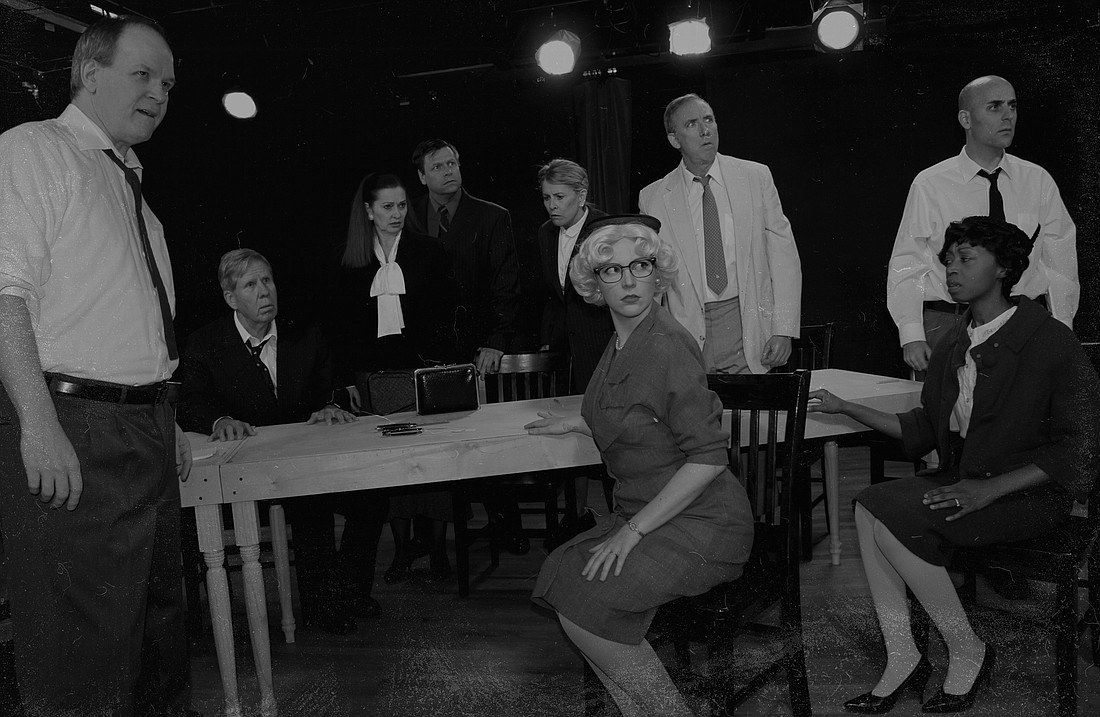- May 3, 2025
-
-
Loading

Loading

“12 Angry Jurors” is essentially Reginald Rose’s “Twelve Angry Men” (1957) with a few discreet pronoun substitutions. The gender-inclusive jury is now in session at the Players Backstage.
Screenwriters would call this a “bottle story.” Basically, cram a mismatched bunch of characters in the same room and turn up the heat. (Or cold, as in the case of Quentin Tarantino’s “The Hateful Eight.”)
Here, the “bottle” is a jury room in New York City in the mid-1950s. The “heat” is the urgent need to reach a unanimous verdict. It looks like an open-and-shut case. A 16-year-old boy (from some unspecified, slum-dwelling ethnic group) is accused of stabbing his abusive father with a switchblade. The elderly neighbor in the flat below heard him shout, “I’ll kill you!” A woman in the tenement on the other side of an elevated train track says she saw the deed through an open window. The kid’s alibi? He claims he was at a late-night movie during the murder, but can’t remember which one. An obvious lie! Send him to the electric chair and let’s go home! Eleven jurors quickly agree to a guilty verdict. But Juror #8 (Carrie McQueen) is the lone holdout. She’s not saying the kid’s necessarily innocent. But she still has a shadow of a doubt about his guilt. Until that shadow’s removed, she wants to go over the case. So let’s talk.
That infuriates the other jurors. They’ve made up their minds — but Juror #8 wants to pry the case open. They just want to go home or catch the ballgame. Thanks to her, they’re still bottled up in a lousy jury room.
Debate ensues, not always rational. The other jurors try to shut her up and kill the deliberation.
"I think the guy’s guilty. You couldn’t change my mind if you talked for a hundred years."
Despite the hostility, Juror # 8 won’t budge. She picks the prosecution’s case apart. One by one, she opens the other jurors’ minds. But Juror #3 (Jim Floyd) won’t budge either. He’s the angriest juror of all.
Rose has a sharp ear for dialog — though it can get a bit didactic. Director Elliot Raines keeps his eye on emotional truth, not polemics. He’s not trying to teach you a civics lesson. He’s showing you the human heart in conflict. That’s where his heart is at.
The play’s nameless characters are a mixed bag of mid-20th-century Americans. They’re individualized, with only passing hints to their professions. These include a salesman (Paul Hutchison), an adman (Chris Hines) and a high school coach (Dylan Jones). There are also hints of prejudice. For some, that’s racism. Juror #10 (Lynne Doyle) wants the kid to die, guilty or not, because she hates “those people.” For others, it’s personal. Floyd (who reminds me of one of Kurtwood Smith’s testosterone-poisoned bad guys) delivers a white-hot portrayal of Juror #3. His character is murderously visceral in the scene when Juror #8 questions his executioner’s zeal. (Juror #3’s own son had once attacked him and rejected him. The trial’s young defendant is a scapegoat — but he doesn’t want to face it.) Other characters (like Jae Hermann’s Juror #5, Michele Strauss’s Juror #11, and Charlie Tyler’s Juror #9) oppose prejudice with conviction. It’s heartening to see them gradually open their minds.
Raines’ production has a film noir vibe. His jury room set is monochromatic, ugly and drab. Except for a few splashes of color, Andrea Bloom’s costumes are monochromatic, too. The play’s issues aren’t black and white. But the mood is. The result is compelling theater.
Some of the play’s issues offer a window into the last century.
Sadly, some are still with us in this one.